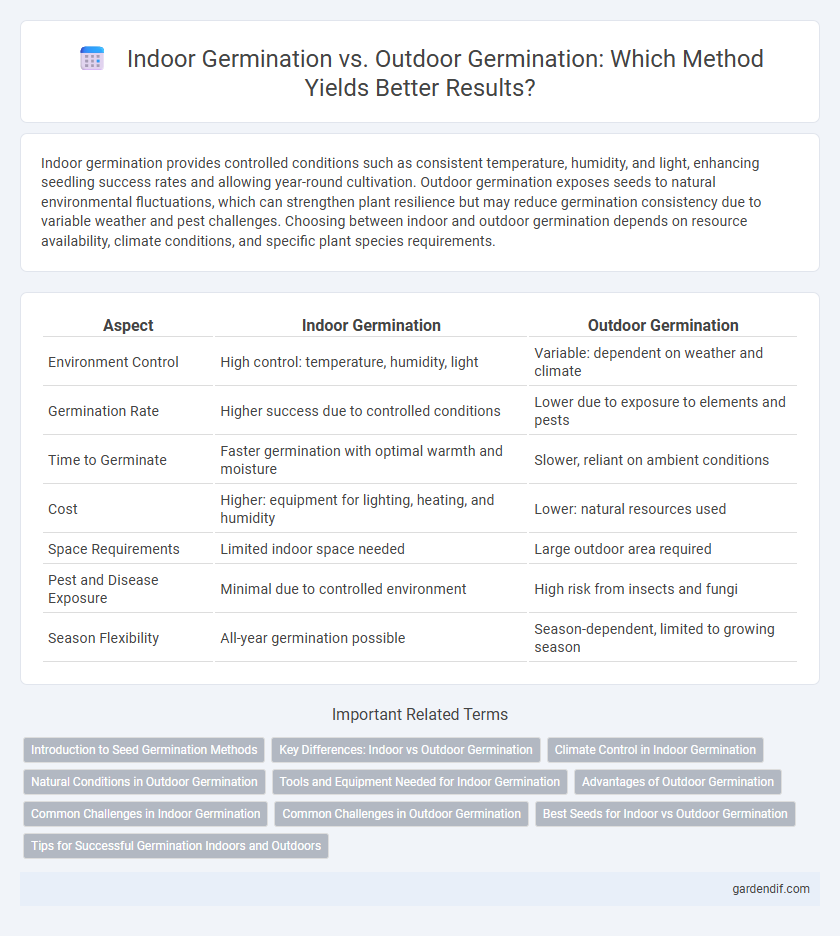
Indoor Germination vs Outdoor Germination Illustration
Indoor germination provides controlled conditions such as consistent temperature, humidity, and light, enhancing seedling success rates and allowing year-round cultivation. Outdoor germination exposes seeds to natural environmental fluctuations, which can strengthen plant resilience but may reduce germination consistency due to variable weather and pest challenges. Choosing between indoor and outdoor germination depends on resource availability, climate conditions, and specific plant species requirements.
Table of Comparison
| Aspect | Indoor Germination | Outdoor Germination |
|---|---|---|
| Environment Control | High control: temperature, humidity, light | Variable: dependent on weather and climate |
| Germination Rate | Higher success due to controlled conditions | Lower due to exposure to elements and pests |
| Time to Germinate | Faster germination with optimal warmth and moisture | Slower, reliant on ambient conditions |
| Cost | Higher: equipment for lighting, heating, and humidity | Lower: natural resources used |
| Space Requirements | Limited indoor space needed | Large outdoor area required |
| Pest and Disease Exposure | Minimal due to controlled environment | High risk from insects and fungi |
| Season Flexibility | All-year germination possible | Season-dependent, limited to growing season |
Introduction to Seed Germination Methods
Seed germination methods vary primarily between indoor and outdoor environments, each offering distinct advantages for early plant development. Indoor germination provides a controlled climate with consistent temperature, moisture, and light, promoting higher germination rates and reduced risk of pests and diseases. Outdoor germination relies on natural conditions such as soil quality, ambient temperature, and rainfall, which can influence growth variability but fosters hardier seedlings adapted to the local environment.
Key Differences: Indoor vs Outdoor Germination
Indoor germination offers controlled temperature, humidity, and light conditions, enhancing seedling success rates compared to outdoor germination, which is influenced by unpredictable weather and soil quality. Seeds germinated indoors often experience faster and more uniform sprouting due to consistent environments, while outdoor germination relies on natural cycles and may delay growth during adverse conditions. Key differences include risk of pests and diseases outdoors versus the energy costs and space limitations of indoor setups.
Climate Control in Indoor Germination
Indoor germination offers precise climate control, allowing for optimal temperature, humidity, and light conditions that enhance seed sprouting rates and seedling vigor. Unlike outdoor germination, where environmental variables such as fluctuating temperatures and unpredictable weather can hinder early growth stages, indoor setups utilize controlled environments like grow tents or propagation mats. This consistent climate regulation promotes uniform germination and reduces risks of fungal infections and seedling stress.
Natural Conditions in Outdoor Germination
Outdoor germination relies on natural conditions such as sunlight, air circulation, and soil microbes, which create an optimal environment for seed sprouting and root development. The variability in temperature and moisture outdoors can enhance seed hardiness and promote stronger, more resilient seedlings. Exposure to natural elements reduces the risk of fungal infections commonly associated with indoor environments.
Tools and Equipment Needed for Indoor Germination
Indoor germination requires specific tools such as seed trays, humidity domes, heating mats, and grow lights to create a controlled environment that promotes optimal seed sprouting. These equipment pieces help regulate temperature, moisture, and light exposure, ensuring consistent conditions regardless of external weather fluctuations. Compared to outdoor germination, where natural soil and sunlight are used, indoor setups demand investment in technology to mimic ideal growth parameters for successful seed development.
Advantages of Outdoor Germination
Outdoor germination offers natural sunlight essential for photosynthesis, promoting stronger and healthier seedling growth. Exposure to natural weather conditions like rain and wind hardens plants, increasing their resilience compared to indoor-germinated seedlings. The outdoor environment also facilitates beneficial soil microorganisms that enhance nutrient uptake during the germination process.
Common Challenges in Indoor Germination
Indoor germination often faces challenges such as inconsistent humidity levels, inadequate airflow, and insufficient natural light, which can hinder seed sprouting and seedling development. Maintaining optimal temperature around 70-75degF and ensuring proper moisture without waterlogging are critical for successful germination indoors. Pest intrusion and mold growth also commonly disrupt indoor germination environments, requiring vigilant monitoring and control measures.
Common Challenges in Outdoor Germination
Outdoor germination often faces challenges such as unpredictable weather conditions, pests, and inconsistent soil quality, which can hinder seed sprouting and seedling survival. Temperature fluctuations and excessive moisture or drought stress frequently reduce germination rates and seedling vigor. Pest infestations, including insects and birds, can damage seeds and young plants, further complicating outdoor germination success.
Best Seeds for Indoor vs Outdoor Germination
Best seeds for indoor germination include herbs like basil, parsley, and cilantro due to their controlled environment requirements and faster growth cycles. Outdoor germination favors hardy seeds such as tomatoes, beans, and sunflowers that thrive in natural sunlight and varying weather conditions. Selecting seeds based on germination conditions ensures optimal sprouting rates and plant health tailored to indoor or outdoor settings.
Tips for Successful Germination Indoors and Outdoors
Maintain consistent temperature and humidity levels indoors by using seedling heat mats and humidity domes to create an optimal germination environment. Outdoors, select a well-drained soil site with partial sunlight and protect seeds from pests using barriers or natural repellents. Regularly monitor moisture levels in both environments to prevent seed drying or waterlogging for successful germination.
Indoor Germination vs Outdoor Germination Infographic

 gardendif.com
gardendif.com